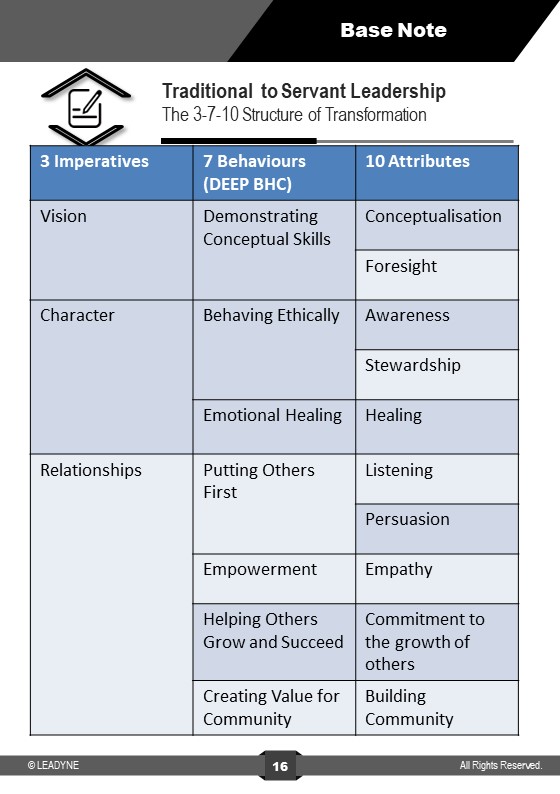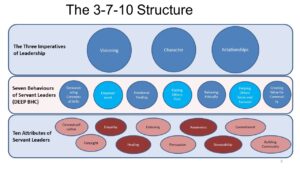While the concept of Servant Leadership is relatively known and even admired, when it comes to the question of implementation, many leaders and organisations falter.
This is why I have come up with the 3-7-10 framework of implementation for Servant Leadership.
- There are three imperatives that we need to embrace . These are Vision, Character and Relationships.
- Vision: One of the key myths about Servant Leadership is that Servant Leaders are not visionary leaders. This is far from the truth. Servant Leaders provide a vision that is a higher purpose vision for themselves and their organisations. This imperative is what bursts the oxymoron nature of Servant Leadership. Ken Blanchard says Leadership is about going somewhere. If you and your people don’t know where you are going, your leadership doesn’t matter. (Jesse Stoner, Ken Blanchard and Drea Zigami. Leading at a Higher level. Blanchard on Leadership and Creating High Performing Organisations. Chapter 2. Blanchard International. 2010. Pp17 )
- Character: Character is what makes us who we are. Character is a choice. Every time we exercise a choice in situations, we are molding our character. Character influences our behaviour significantly. Servant Leaders work on developing the right character traits in themselves and others.
- Relationships: Leadership could become very lonely unless leaders nurture relationships with others. In an organisational context, processes can get you only average results. It is relationships that will get your excellent results. Servant Leaders pay high attention to building and nurturing relationships with all stakeholders
- These three imperatives are out into practice through observable behaviours. We call them the DEEP BHC behaviours (you can read the descriptions of the DEEP BHC behaviours here). These behaviours are measurable through a 360 degree assessment. (more here)
- When a leader wants to improve on any particular behaviour, he/she will need to work on several attributes. There are ten attributes that one might need to work on. You can read about the attributes here.
Sometimes it might look overwhelming to look at all of them. That is why we have arrived at a mapping between the Imperatives, Behaviours and Attributes. When in doubt, start with the what is mapped. But the mapping is not sacrosanct. All of them interact with each other. The mapping is provided to make it easier to get started. Once you get started, you will get the hang of what other elements you need to work on.
The mapping is given below

________________________________________________________
 The author Dr. Madana Kumar, PhD is the Servant Leadership Evangelist at Leadyne. You can connect with him here or contact him here.
The author Dr. Madana Kumar, PhD is the Servant Leadership Evangelist at Leadyne. You can connect with him here or contact him here.



